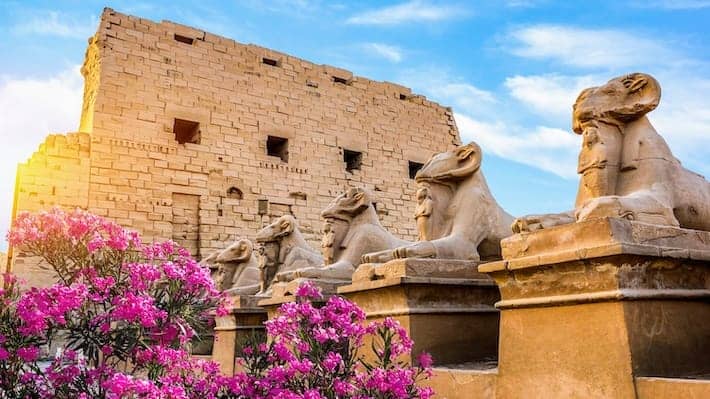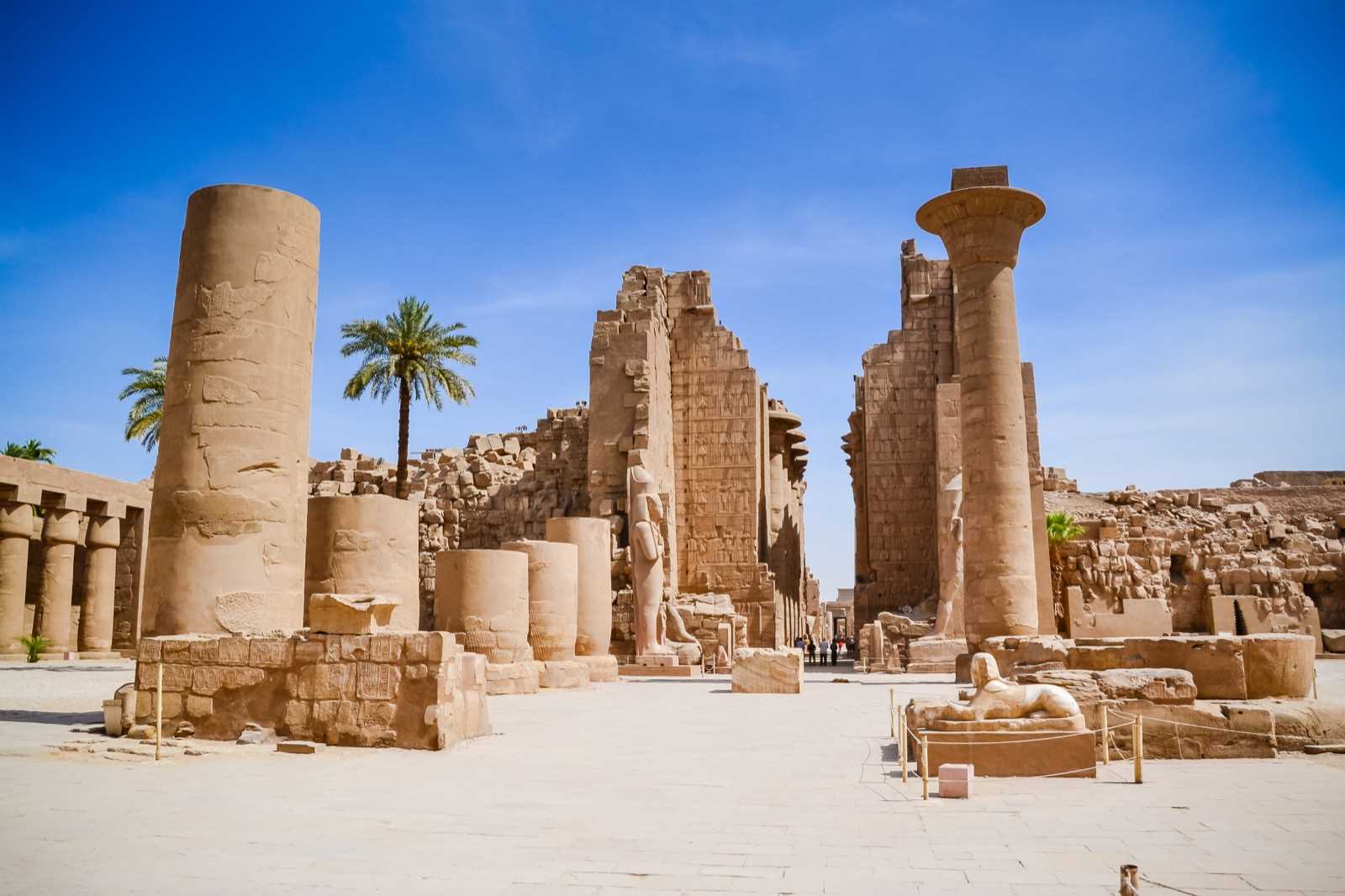Karnak Temple: Decoding the Secrets of Egypt’s Most Epic Monument
Decoding the Secrets of Egypt’s Most Epic Monument

History of Karnak Temple
Construction of Karnak Temple
The construction of Karnak Temple began around 2055 BC and spanned centuries under the reigns of numerous pharaohs. This monumental project symbolizes the grandeur of ancient Egyptian architecture. Imagine craftsmen laboring for decades, sculpting monumental stones and intricate hieroglyphs, creating a space that would serve as a focal point for worship.
Key highlights of the construction include:
- Pharaohs: Multiple rulers, including Ramses II and Hatshepsut, contributed to its expansion.
- Materials: Local limestone and granite were predominantly used for the structures.
- Techniques: Skilled artisans employed advanced engineering principles of the time.
Significance in Ancient Egypt
Karnak Temple served as a center for religion and politics, influencing the spiritual lives of the Egyptians profoundly. It was dedicated primarily to Amun-Ra, the sun god, and stood as a symbol of divine power.
- Pilgrimage Site: Millions of worshippers visited annually.
- Rituals: Important ceremonies took place, celebrating the gods and securing blessings for the pharaohs.
The temple’s very existence underscored the Egyptians’ deep connection between spirituality and governance, making it a treasured landmark in their cultural heritage.

Architecture and Layout
Temple Complex Structure
Transitioning from its rich history, the architectural marvel of Karnak Temple deserves special attention. The temple complex is a sprawling site covering over 200 acres, making it one of the largest religious complexes in the world. Imagine walking through vast courts and towering structures that reflect the meticulous planning of the ancient Egyptians.
- Enclosed Walls: Massive walls delineate the sacred areas.
- Avenue of Sphinxes: This pathway connects Karnak to Luxor Temple, lined with majestic statues.
Main Features and Sections
The layout comprises several key features that showcase the ingenuity of its creators:
- Hypostyle Hall: A breathtaking space with 134 massive columns, each intricately carved.
- Obelisks: Standing as sentinels, these needle-like structures channel the power of the sun.
Each segment of the temple complex was purposefully designed, creating a harmonious blend of spirituality and artistry that continues to captivate visitors today.

Mythology and Religious Significance
Deities Worshipped at Karnak
Continuing within the hallowed grounds of Karnak Temple, one cannot overlook the pantheon of deities who were central to its worship. The temple primarily honored Amun-Ra, the king of gods, but it also embraced several other influential deities.
- Mut: Amun’s divine consort, embodying motherhood and fertility.
- Khonsu: The moon god, representing time and healing.
Each deity played a crucial role in the daily lives of the ancient Egyptians, making Karnak a vibrant hub for spiritual connection.
Rituals and Ceremonies
The rituals performed at Karnak reflected the deep reverence the Egyptians held for their gods. Imagine congregations gathering for grand ceremonies that transcended mere observance; they were lifelines to the divine.
Key rituals included:
- The Opet Festival: Celebrated the relationship between Amun and the pharaoh.
- Daily Offerings: Priests prepared elaborate presentations of food, incense, and music to honor the gods.
These ceremonies not only reinforced the community’s spirituality but also served as a vital aspect of maintaining cosmic order. Each event resonated with the enduring belief that the gods directly influenced their everyday lives.

Exploration and Excavation
Discovery of Karnak Temple
Transitioning from the rich religious practices at Karnak, let’s delve into its fascinating rediscovery. Although known to locals for centuries, the temple complex truly caught the attention of Western explorers in the 18th century. Imagine the awe of these early adventurers, stumbling upon towering pillars and intricate hieroglyphics hidden beneath centuries of sand.
- Initial Surveys: Conducted by explorers like James Bruce in 1769.
- Formal Excavations: Began in the 19th century, unveiling the temple’s grandeur.
Archaeological Finds and Research
The excavation efforts revealed treasures that deepened our understanding of ancient Egypt. Researchers have unearthed various artifacts, from inscriptions to statues, that paint a vivid picture of its historical context.
Notable finds include:
- Statues of Pharaohs and Deities: These shaped our understanding of religious iconography.
- Inscribed Stele: Providing insights into the rituals conducted.
These significant archaeological discoveries continue to enrich scholarly research, showcasing the temple’s importance in ancient Egyptian civilization and fueling ongoing fascination across the globe.

Symbolism and Hieroglyphics
Interpretation of Hieroglyphics
Building on the incredible archaeological discoveries at Karnak, the hieroglyphics etched into its walls reveal stories waiting to be unravelled. These ancient symbols were more than mere writing; they served as a sacred language bridging the divine and the mortal world.
- Common Symbols:
- Ankh: Represents life.
- Was Scepter: Symbolizes power.
With each symbol, the rich tapestry of stories about pharaohs, gods, and daily life come to life, connecting us with ancient beliefs.
Symbolic Meaning in Karnak’s Artwork
Karnak’s artwork further enhances these narratives, with every carving chosen to convey meaning. Consider the monumental reliefs depicting significant rituals or victories—each holds deeper significance beyond beauty.
- Victory Scenes: Often show pharaohs triumphing over enemies, symbolizing divine favor.
- Deity Representations: Gods are depicted interactively, showing their influence over various aspects of life.
Through these artworks, we gain insight into the values, beliefs, and aspirations of ancient Egyptians, capturing the essence of a civilization that continues to inspire awe.

Modern-Day Preservation Efforts
Conservation Challenges
As we reflect on the artistic brilliance of Karnak Temple, it’s crucial to acknowledge the ongoing conservation challenges it faces today. Preserving such a monumental site requires constant attention and resources.
- Environmental Factors: Pollution and weathering wear down stone surfaces.
- Funding Limitations: Many conservation projects struggle for financial support.
These obstacles make it challenging to maintain the integrity and splendor of this ancient wonder, but efforts continue to ensure its survival.
Tourism and Visitor Impact
While tourism boosts local economies, it also places immense pressure on the site. Each year, millions flock to witness Karnak’s majestic beauty, which brings both benefits and challenges.
- Foot Traffic: Increased visitor numbers can lead to wear and deterioration.
- Management Efforts: Implementing pathways and controlled access to sensitive areas helps mitigate damage.
Finding a balance between accessibility and preservation is critical, ensuring future generations can appreciate the awe-inspiring legacy of Karnak Temple.

Legacy of Karnak Temple
Influence on Egyptian Culture
Reflecting on the enduring legacy of Karnak Temple, its influence on Egyptian culture is profound. The architectural styles, religious practices, and artistic expressions inspired by this monumental site shaped the backdrop of ancient Egyptian life.
- Art and Architecture: Karnak’s designs influenced other temples, establishing a gold standard for grandeur.
- Religious Practices: Festivals held at Karnak set templates for spiritual observances throughout Egypt.
Such cultural impact underscores how deeply ingrained Karnak remains in Egypt’s historical narrative.
Continued Mystique and Global Interest
Today, the mystique of Karnak Temple continues to captivate people worldwide. Travelers and scholars are drawn to its ancient wonders for various reasons.
- Tourism Growth: Increasing numbers of visitors explore its expansive sites annually.
- Media Representation: Documentaries and books ignite interest in its stories.
The Temple’s blend of history and mythology ensures that Karnak remains a focal point for those seeking to unlock the secrets of ancient Egypt, keeping its legacy alive for generations to come.




